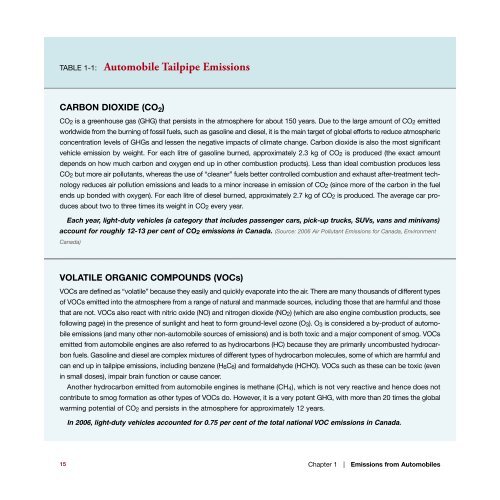Primer on Automobile Fuel Efficiency and Emissions - Pollution Probe
Primer on Automobile Fuel Efficiency and Emissions - Pollution Probe
Primer on Automobile Fuel Efficiency and Emissions - Pollution Probe
You also want an ePaper? Increase the reach of your titles
YUMPU automatically turns print PDFs into web optimized ePapers that Google loves.
TABLE 1-1:<br />
<strong>Automobile</strong> Tailpipe Emissi<strong>on</strong>s<br />
CARBON DIOXIDE (CO 2 )<br />
CO 2 is a greenhouse gas (GHG) that persists in the atmosphere for about 150 years. Due to the large amount of CO 2 emitted<br />
worldwide from the burning of fossil fuels, such as gasoline <strong>and</strong> diesel, it is the main target of global efforts to reduce atmospheric<br />
c<strong>on</strong>centrati<strong>on</strong> levels of GHGs <strong>and</strong> lessen the negative impacts of climate change. Carb<strong>on</strong> dioxide is also the most significant<br />
vehicle emissi<strong>on</strong> by weight. For each litre of gasoline burned, approximately 2.3 kg of CO 2 is produced (the exact amount<br />
depends <strong>on</strong> how much carb<strong>on</strong> <strong>and</strong> oxygen end up in other combusti<strong>on</strong> products). Less than ideal combusti<strong>on</strong> produces less<br />
CO 2 but more air pollutants, whereas the use of “cleaner” fuels better c<strong>on</strong>trolled combusti<strong>on</strong> <strong>and</strong> exhaust after-treatment technology<br />
reduces air polluti<strong>on</strong> emissi<strong>on</strong>s <strong>and</strong> leads to a minor increase in emissi<strong>on</strong> of CO 2 (since more of the carb<strong>on</strong> in the fuel<br />
ends up b<strong>on</strong>ded with oxygen). For each litre of diesel burned, approximately 2.7 kg of CO 2 is produced. The average car produces<br />
about two to three times its weight in CO 2 every year.<br />
Each year, light-duty vehicles (a category that includes passenger cars, pick-up trucks, SUVs, vans <strong>and</strong> minivans)<br />
account for roughly 12-13 per cent of CO 2 emissi<strong>on</strong>s in Canada. (Source: 2006 Air Pollutant Emissi<strong>on</strong>s for Canada, Envir<strong>on</strong>ment<br />
Canada)<br />
VOLATILE ORGANIC COMPOUNDS (VOCs)<br />
VOCs are defined as “volatile” because they easily <strong>and</strong> quickly evaporate into the air. There are many thous<strong>and</strong>s of different types<br />
of VOCs emitted into the atmosphere from a range of natural <strong>and</strong> manmade sources, including those that are harmful <strong>and</strong> those<br />
that are not. VOCs also react with nitric oxide (NO) <strong>and</strong> nitrogen dioxide (NO 2) (which are also engine combusti<strong>on</strong> products, see<br />
following page) in the presence of sunlight <strong>and</strong> heat to form ground-level oz<strong>on</strong>e (O 3). O 3 is c<strong>on</strong>sidered a by-product of automobile<br />
emissi<strong>on</strong>s (<strong>and</strong> many other n<strong>on</strong>-automobile sources of emissi<strong>on</strong>s) <strong>and</strong> is both toxic <strong>and</strong> a major comp<strong>on</strong>ent of smog. VOCs<br />
emitted from automobile engines are also referred to as hydrocarb<strong>on</strong>s (HC) because they are primarily uncombusted hydrocarb<strong>on</strong><br />
fuels. Gasoline <strong>and</strong> diesel are complex mixtures of different types of hydrocarb<strong>on</strong> molecules, some of which are harmful <strong>and</strong><br />
can end up in tailpipe emissi<strong>on</strong>s, including benzene (H 6C 6) <strong>and</strong> formaldehyde (HCHO). VOCs such as these can be toxic (even<br />
in small doses), impair brain functi<strong>on</strong> or cause cancer.<br />
Another hydrocarb<strong>on</strong> emitted from automobile engines is methane (CH 4 ), which is not very reactive <strong>and</strong> hence does not<br />
c<strong>on</strong>tribute to smog formati<strong>on</strong> as other types of VOCs do. However, it is a very potent GHG, with more than 20 times the global<br />
warming potential of CO 2 <strong>and</strong> persists in the atmosphere for approximately 12 years.<br />
In 2006, light-duty vehicles accounted for 0.75 per cent of the total nati<strong>on</strong>al VOC emissi<strong>on</strong>s in Canada.<br />
15<br />
Chapter 1 | Emissi<strong>on</strong>s from <strong>Automobile</strong>s
















